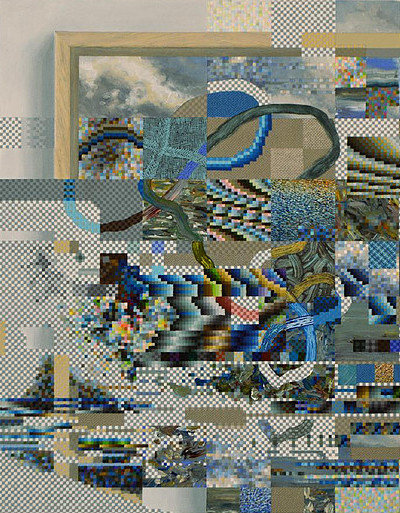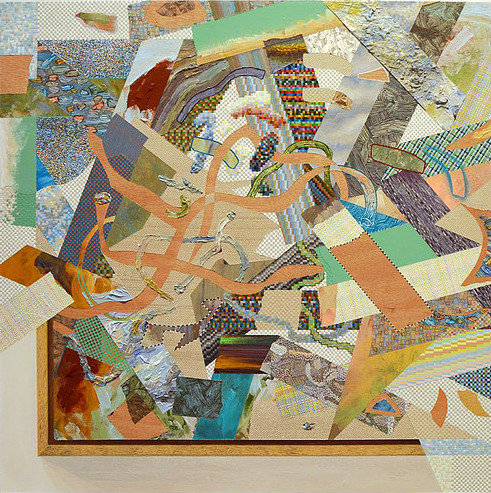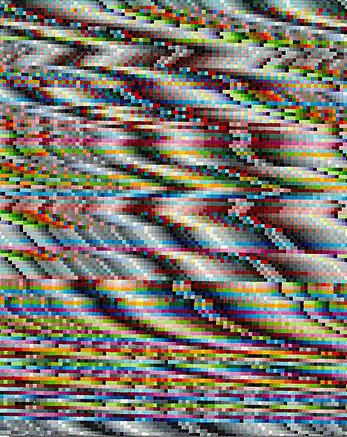Mark Stebbins’ artwork evokes intrigue in it’s material plasticity, subject amalgamation and small scale. The series Among the Jaggies, Along the Seams visually depicts the dynamic relationship between computer and craft. The audience oscillates between notions of hand-made and digitized. The uncertainty of medium and method demonstrates an underlying reciprocal interconnection between digital and textile and the processes of making.
 Mark Stebbins, Dissolution, 2015, acrylic and ink on panel, 14 x 11 inches. Courtesy of Wil Kucey Gallery
Mark Stebbins, Dissolution, 2015, acrylic and ink on panel, 14 x 11 inches. Courtesy of Wil Kucey Gallery
Stebbins’ intricate acrylic compositions deceptively transforms from the painted medium to material and computer collage. His method consists of taping off unique segments and applying different details to each defined area. In this way he achieves a layered effect, with sharp distinctions where some areas become more raised. He details each segment using a varying set of application tools in order to further evoke the amalgamation of multiple materials. Rough textured areas convey a cut and paste effect, while the more seamless variations align with computer renders. The sharp edges and uncomfortable curves created by the tape, recall the trimming mechanisms of computer apparatuses but also handheld scissors, which then become correlated. The rigorous painted application method demonstrates a seriousness between the reciprocity of computer and craft.
 Mark Stebbins, Spatial Complex, 2016, acrylic and ink on panel, 18 x 18 inches. Courtesy of Wil Kucey Gallery
Mark Stebbins, Spatial Complex, 2016, acrylic and ink on panel, 18 x 18 inches. Courtesy of Wil Kucey Gallery
The viewers uncertainty in materiality traverses familiar and abstract realms. Some segments overtly demonstrate the painted medium, revealing the residue of a brush stroke. However, the painted fragments are too magnified to depict a real scene. Pixelated areas evoke computer graphics but not a particular image, also due to the miniscule viewable area. In some works familiar atmospheres or objects become more obvious; the natural sky, a pixelated mug. The artworks evoke both screen and fabric texture. The work can be read as a series of pixels with an arrangement of individual squares or as weaved fabric. In approaching these pieces as textile the work inherits more depth such as interweaving invokes layered materials. Other works simulate material quality with reflection, shadows and color from more natural and muted to bright and neon. This apparent malleability evokes motion from axial to centripetal.
 Mark Stebbins, Dissolution, 2015, acrylic and ink on panel, 14 x 11 inches. Courtesy of Wil Kucey Gallery
Mark Stebbins, Dissolution, 2015, acrylic and ink on panel, 14 x 11 inches. Courtesy of Wil Kucey Gallery
The collaged works’ haphazard amalgamations also evoke the phenomena of computer spasm, where the screen becomes pixelated and distorted. The work becomes situated between the thresholds of intentional and random, crafted and computed, programmed and erratic. Notions of fragments are positioned beside allusions to continuity. Asymmetrical collages compete with perfect squares. The digital world is revealed to be derived from real techniques. In the process of fabrication the physical and digital have become intertwined.
The detailed artwork invites the viewer to approach with a sharp eye. With the largest painting measuring 18 x 18 inches, Stebbins articulates the intricacies that compose the visual world. The viewer must decipher the deceptively clear material representation and ambiguity of the amalgamation.
Nika Teper
*Exhibition information: November 4 – December 3, 2016, Wil Kucey Gallery, 1183 Dundas Street West, Toronto, Wed – Sat, 11 am – 6 pm.
